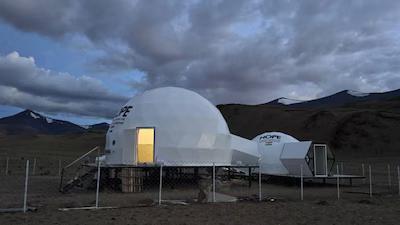
ISRO Sets Up Station in Ladakh to Simulate Life on Moon & Mars
The Indian Space Research Organisation (ISRO) has taken a significant step towards exploring the vast expanse of space by setting up a unique station in Ladakh’s Tso Kar Valley. Dubbed the Himalayan Outpost for Planetary Exploration (HOPE), this facility will simulate the conditions of the Moon and Mars to test life-support systems for future lunar and Martian missions. The station is designed to mimic the harsh environment of these celestial bodies, providing scientists with valuable insights to ensure the success of future space expeditions.
The HOPE station is a temporary setup that will be operational for 10 days, from August 1 to August 10. Two crew members will be stationed at the facility, undertaking various tests and experiments to assess the feasibility of sustaining life in such extreme conditions. The valley was chosen for its striking similarities to the Martian environment, with high UV radiation, low atmospheric pressure, extreme cold, and saline permafrost.
The Tso Kar Valley, located at an altitude of around 4,500 meters, is a pristine and remote region that offers an ideal setting for the HOPE mission. The harsh climate and unique geography of the valley create an environment that is eerily similar to the Martian surface. The low atmospheric pressure, for instance, is similar to the conditions found on Mars, which is about one-third of the Earth’s atmospheric pressure.
The UV radiation in the valley is also significantly higher than the Earth’s average, which is a key aspect of the Martian environment. The extreme cold temperatures, which can drop to as low as -20°C, are also comparable to the frigid conditions found on Mars. Furthermore, the saline permafrost in the valley is a unique feature that is not found in many other places on Earth, making it an ideal location for testing equipment and systems designed for Martian missions.
The HOPE mission is a crucial step towards India’s ambitious plans to explore the Moon and Mars. ISRO has been working towards developing technologies and systems that can sustain life in space for extended periods, and the HOPE station is a vital part of this endeavor. The data collected during the 10-day mission will be used to refine and improve the design of life-support systems, ensuring that future missions are better equipped to handle the challenges of space travel.
The HOPE mission is also significant from a scientific perspective, as it will provide valuable insights into the effects of extreme environments on living organisms. The crew members stationed at the facility will be conducting experiments to study the impact of UV radiation, low pressure, and extreme temperatures on biological systems. This research will have far-reaching implications for the scientific community, as it will help us better understand how to protect humans and other living organisms from the harsh conditions found in space.
ISRO has been actively pursuing its lunar and Martian exploration programs, with several missions planned for the coming years. The HOPE mission is a critical step towards achieving these goals, and the data collected during the 10-day mission will play a vital role in shaping the future of India’s space program.
In conclusion, the HOPE mission is a groundbreaking initiative that marks a significant milestone in India’s space exploration journey. The temporary station set up in Ladakh’s Tso Kar Valley will provide valuable insights into the feasibility of sustaining life on the Moon and Mars, and will play a critical role in refining the design of life-support systems for future missions. As India continues to push the boundaries of space exploration, the HOPE mission is a testament to the country’s commitment to advancing scientific knowledge and pushing the frontiers of human innovation.






